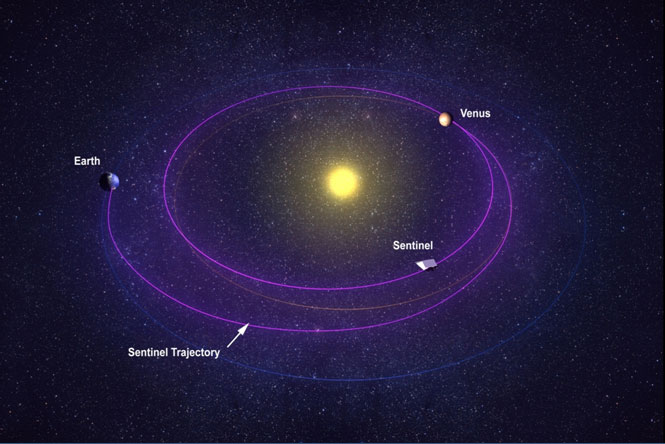Private telescope will operate in 2017
Space telescope built with the world's first private capital, with the goal of exploring 500,000 near-asteroids near Earth, is expected to deploy in 2017.
The Sentinel project team said the work for the Sentinel telescope, funded by the non-profit B612 fund and Ball Aerospace partner, is ongoing and consistent.

Illustration of the location of the Sentinel telescope on Venus's orbit. (Photo: B612)
The project developed an ultra-sensitive telescope placed on orbit around the sun, aiming to create the first comprehensive map of the solar system. This map will provide the current, future and path of the objects near the earth, creating favorable conditions to protect the earth from the impact of meteorites. The map also allows scientists to identify dangerous asteroids before they affect the earth for decades.
Space quoted the project leader, Tom Gavin, saying: 'This is an important milestone in the development of Sentinel. Ball Aerospace has adopted a series of designs and detailed work plans for the project '.
Mr. Ed Lu, chairman and CEO of B612 said, the Sentinel plan is feasible with a high chance of success.
According to the plan, the B612 fund put the Sentinel telescope into operation in 2017 and put the devices near orbiting Venus. Sentinel will observe the universe from that location, tracking the planet near the earth without having to apply anti-glare measures caused by sunlight. Sunlight is often a major obstacle to devices seeking near asteroids.
The telescope's infrared eye can observe about 500,000 asteroids near the earth for nearly 6 years of operation. This will be a miracle, because until now, researchers have only discovered 10,000 asteroids.
Managers of the B612 fund have not given exact cost figures for the Sentinel project. But according to Ed Lu, the number could be in the range of several hundred million dollars.
- The world's largest telescope is ready to operate
- 'Hunting' meteorites with private telescopes
- The world's largest telescope will operate in 2027
- Put the telescope on the moon
- The most terrible telescope starts
- The European flight observatory is blind
- The largest telescope in the Southern Hemisphere is about to operate
- China launched its first private missile failure into orbit
- China will build the second giant telescope to find aliens
- Hale telescope - Legend of the telescope world
- NASA is developing a telescope capable of saving humanity
- Commencement of the world's largest telescope project in Chile
 Norway built the world's tallest wooden tower
Norway built the world's tallest wooden tower Kremlin
Kremlin Ashurbanipal: The oldest royal library in the world
Ashurbanipal: The oldest royal library in the world Decoding the thousand-year construction of Qin Shihuang shocked the world
Decoding the thousand-year construction of Qin Shihuang shocked the world